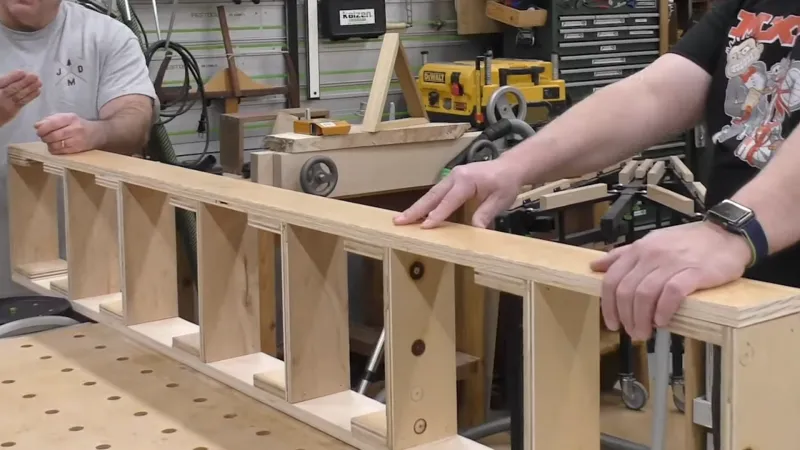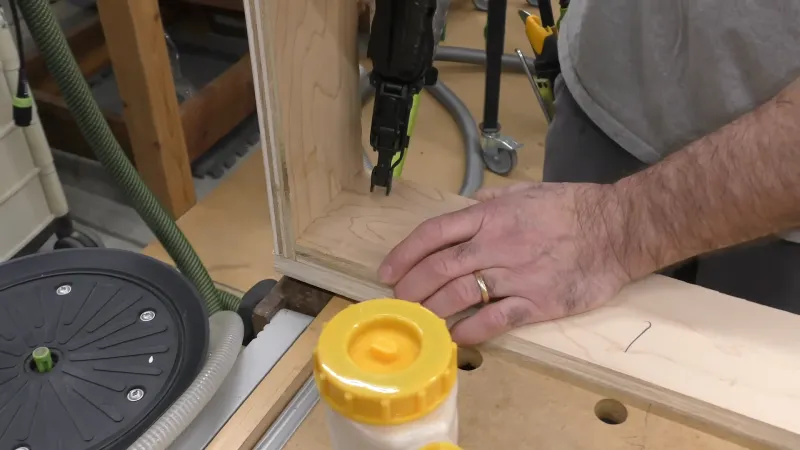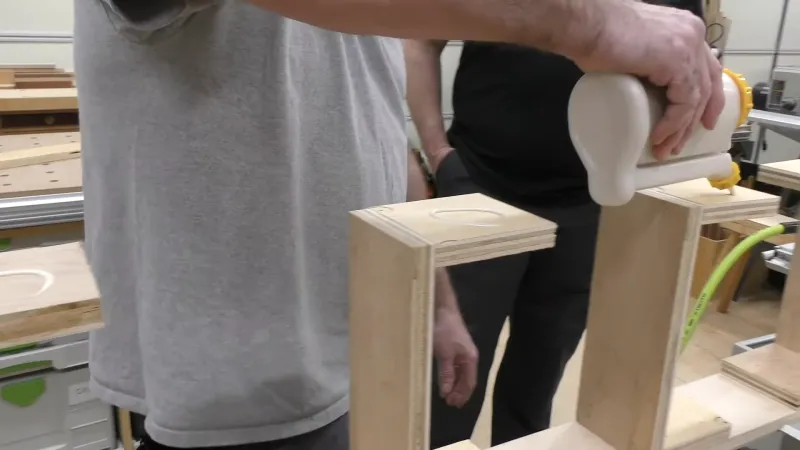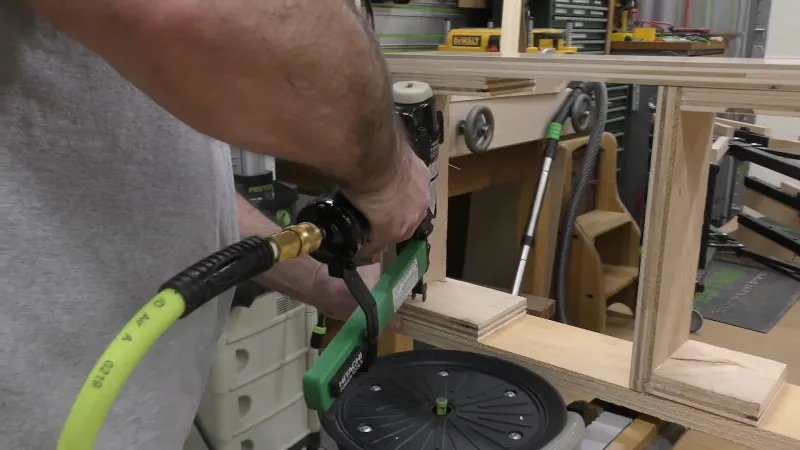Should I Glue or Nail Cabinet Toe Kick?

Strong and long-lasting hold: Glue is a strong adhesive that can hold the toe kick plate in place for a long time. It is particularly useful in cases where the toe kick plate will be subjected to heavy loads or constant use.
Quick and easy installation: Attaching a toe kick plate with nails is a quick and straightforward process. It is especially useful if you need to install the toe kick plate in a short amount of time or if you are working on a large project with many toe kick plates.
Material of the toe kick plate: The material of the toe kick plate will impact the best method of attachment. For example, wood may be better suited for nails, while composite or plastic materials may work better with glue.
You'll Learn About
Glue or Nail Cabinet Toe Kick
To attach a toe kick plate to the bottom of kitchen cabinets, you can use a strong adhesive, such as FuzeIt, or use a brad nailer to attach it with nails. You can use a thin material, such as the white coated masonite sold at home improvement stores, or you can opt for something thicker, such as composite PVC wood or real wood.
It’s generally recommended to use a separate piece for the area under the dishwasher, as this will allow easy access for servicing the appliance. When attaching the toe kick plate, you can either glue it in place or use nails, screws, or a combination of both. Consider the material and style of the toe kick plate, as well as the overall aesthetic of your kitchen, when making your decision.

Advantages of Using Glue
I. Strong and Long-lasting Hold
Glue is a strong adhesive that can hold the toe kick plate in place for a long time. It is particularly useful in cases where the toe kick plate will be subjected to heavy loads or constant use. This is because glue creates a strong bond between the two materials, which can withstand a lot of wear and tear.
II. No Visible Nail Holes
Using glue to attach the toe kick plate means that there will be no visible nail holes on the surface. This can be a desirable feature if you want a seamless, finished look for your kitchen. It can also be useful if you are working with a material that is prone to splitting or cracking when nails are used, as glue creates a bond without puncturing the material.

III. Can Be Used on a Variety of Materials
Glue can be used to attach a toe kick plate to a wide range of materials, including wood, composite, and plastic. This makes it a versatile option for attaching toe kick plates, as it can be used on a variety of surfaces. Additionally, glue is often easier to work with than nails, as it does not require the use of specialized tools such as a nail gun.
Advantages of Using Nails
I. Quick and Easy Installation
Attaching a toe kick plate with nails is a quick and straightforward process. It is especially useful if you need to install the toe kick plate in a short amount of time or if you are working on a large project with many toe kick plates. Using a nail gun can speed up the process even more, as it allows you to quickly and easily place nails in the desired location.
II. Can Be Easily Removed or Adjusted
If you need to remove or adjust the toe kick plate at a later date, nails can be easily removed or adjusted. This is not always possible with glue, as it can be difficult to remove without damaging the material. Using nails also allows for greater flexibility in terms of adjusting the position of the toe kick plate, as you can simply remove and reposition the nails as needed.

III. Can Provide Additional Support for Heavy Loads
Nails can provide additional support and stability for heavy loads, such as appliances or large pots and pans. This can be particularly useful in a busy kitchen where the toe kick plate is subjected to a lot of wear and tear. Nails can also be used to reinforce the attachment of the toe kick plate, especially if the material is prone to sagging or shifting under heavy loads.
Factors to Consider When Deciding Between Glue or Nails
Material of the Toe Kick Plate
The material of the toe kick plate will impact the best method of attachment. For example, wood may be better suited for nails, as they can be easily removed or adjusted if needed. On the other hand, composite or plastic materials may work better with glue, as it creates a strong bond without puncturing the material. Consider the specific characteristics of the material you are working with when deciding between glue or nails.
Weight of the Toe Kick Plate
The weight of the toe kick plate will also influence the best method of attachment. If the toe kick plate is very heavy, nails may provide more support and stability than glue. This is because nails create a physical connection between the two materials, which can better support heavy loads. On the other hand, if the toe kick plate is relatively lightweight, glue may be sufficient to hold it in place.
Visibility of Nail Holes
Consider whether the nail holes will be visible on the surface of the toe kick plate. If you want a seamless, finished look, glue may be a better choice as it does not leave visible nail holes. On the other hand, if the nail holes will not be visible or if they can be easily covered up, nails may be a suitable option.
Accessibility of the Toe Kick Plate for Future Adjustments or Repairs
Consider whether you may need to remove or adjust the toe kick plate in the future. If so, nails may be a better choice as they can be easily removed or adjusted. On the other hand, if the toe kick plate is not likely to need future adjustments or repairs, glue may be sufficient to hold it in place.
How to Attach Toe Kicks?
- Measure the length of the toe kick and cut it to size if necessary.
- Clean the surface of the cabinet where the toe kick will be attached.
- Apply a small amount of glue to the back of the toe kick, making sure it is evenly distributed.
- Carefully position the toe kick on the cabinet, ensuring that it is level and straight.
- Use a clamp or a few heavy books to hold the toe kick in place while the glue dries.
- Allow the glue to dry completely, following the manufacturer’s recommended drying time.
- Use a putty knife to remove any excess glue that may have squeezed out during the process.
- Sand the toe kick to smooth out any rough edges, and then paint or stain it to match the cabinet.
- Install any hardware such as nails, if desired.
- Allow the paint or stain to dry completely before use.
Final Words
Both has the pros and cons of using glue or nails for attaching a toe kick plate. So, consider the specific needs and circumstances of the installation when making a decision. You also might want to know about uponor wait time.
